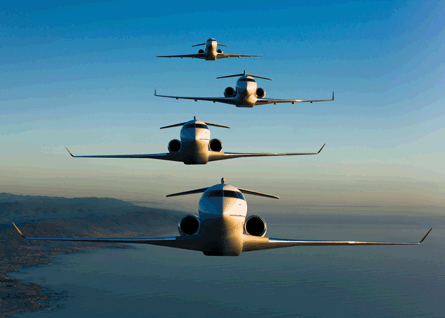Bombardier's new Global twins aim to eclipse Gulfstream's G650 by many important metrics, including price.
The Global 7000 and 8000 started life more than two years ago as a single code-named aircraft, the M170, a 7000nm (13,000km) jet, roughly the same size as today's Global Express XRS.
That first concept later morphed into two aircraft with the help of 150 Bombardier Global customers, which divided themselves into two distinct categories; one group prioritizing range, and the other, cabin space.
"As wealth was spreading across the globe, we saw the need for a longer-range airplane," says Brad Nolan, director of product planning for Bombardier business aircraft. "We also saw customers who were more centrally located on the globe, but a key group of operators was looking for absolutely the largest cabin in business aviation."
 |
|---|
© Bombardier |
Bombardier aims to best the high-speed range of the Gulfstream G650, with long legs of 5,650nm and 5,100nm at Mach .90 for the Global 8000 and 7000, and 7,900nm and 7,300nm at Mach .85, respectively. Gulfstream announced Monday that its G650 has validated its 5,000nm range at a M.90 cruising speed.
The Global 7000 and 8000 will also sport price tags of $65 million in 2010 dollars, compared with around $58.5 million for the Gulfstream G650.
The two new jets will take elements from the existing Global Express XRS and 5000 for the 7000 and 8000. The 7000 and 8000 will be 135in (3.4m) and 27in longer than the Global Express XRS, respectively. Additionally, the horizontal and vertical tail will be mostly common across the Global family.
The all-new wing, one of two sources for the Global 7000 and 8000's long legs, is currently in wind tunnel testing, says Steve Ridolfi, President, Bombardier Business Aircraft.
The other major investment for the new Global 7000 and 8000 will be the General Electric TechX, which Bombardier says will be enable a 14% and 18% improvement in fuel efficiency over other long-range business jets, respectively.
On the flight deck, Ridolfi says the Global Vision flight test program for the Global Express XRS and Global 5000 have served as a technological "building block" for the Rockwell Collins Pro Line Fusion avionics that will be employed on the 7000 and 8000.
The Global 7000 and 800 will enter service in 2016 and 2017 respectively.
Source: Flight Daily News
















